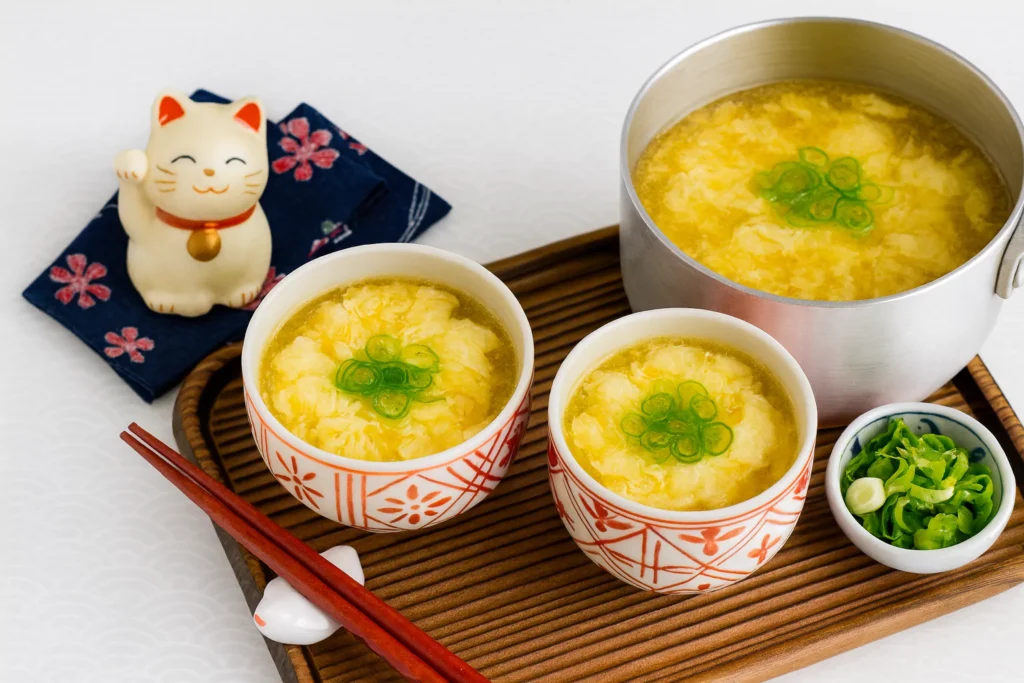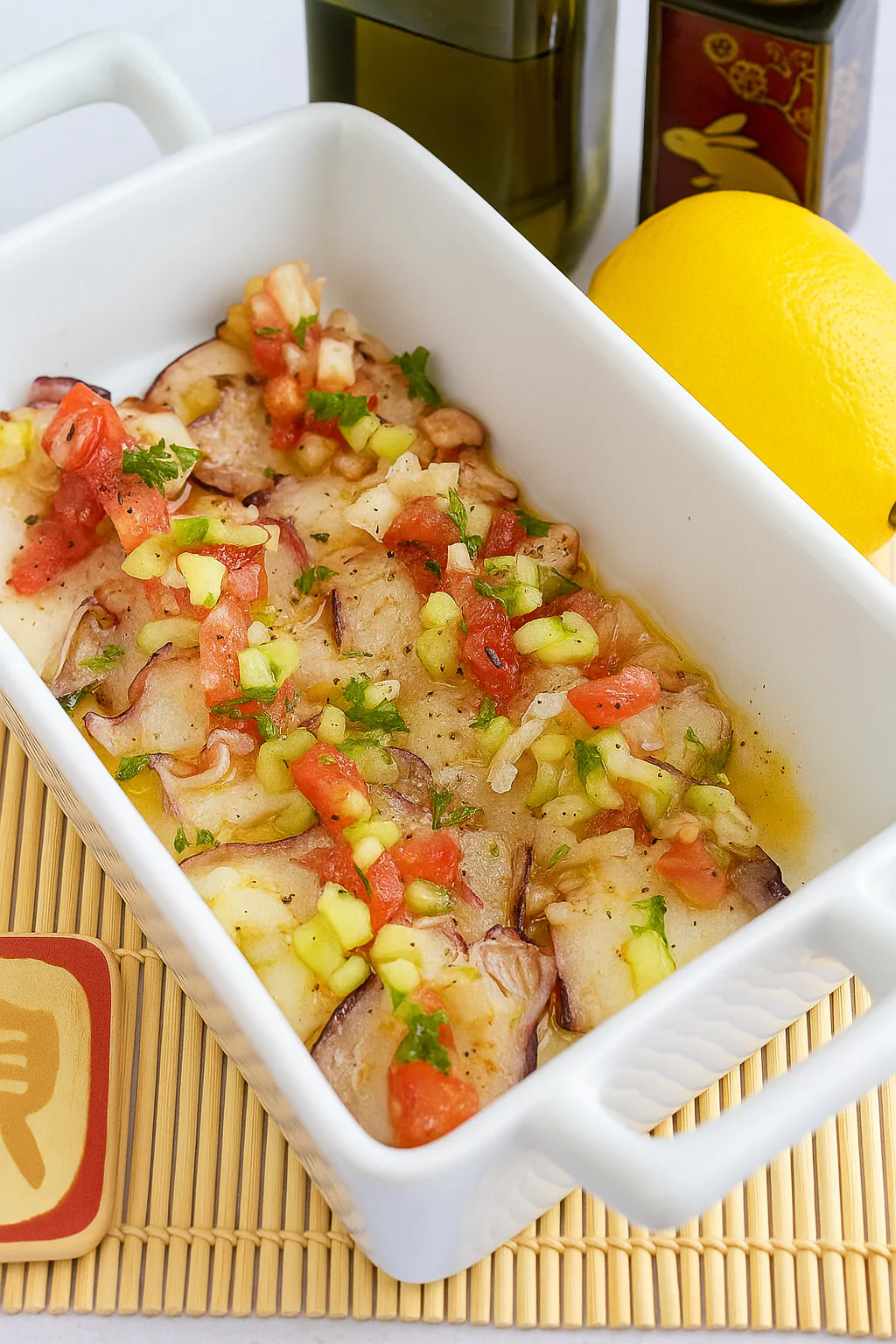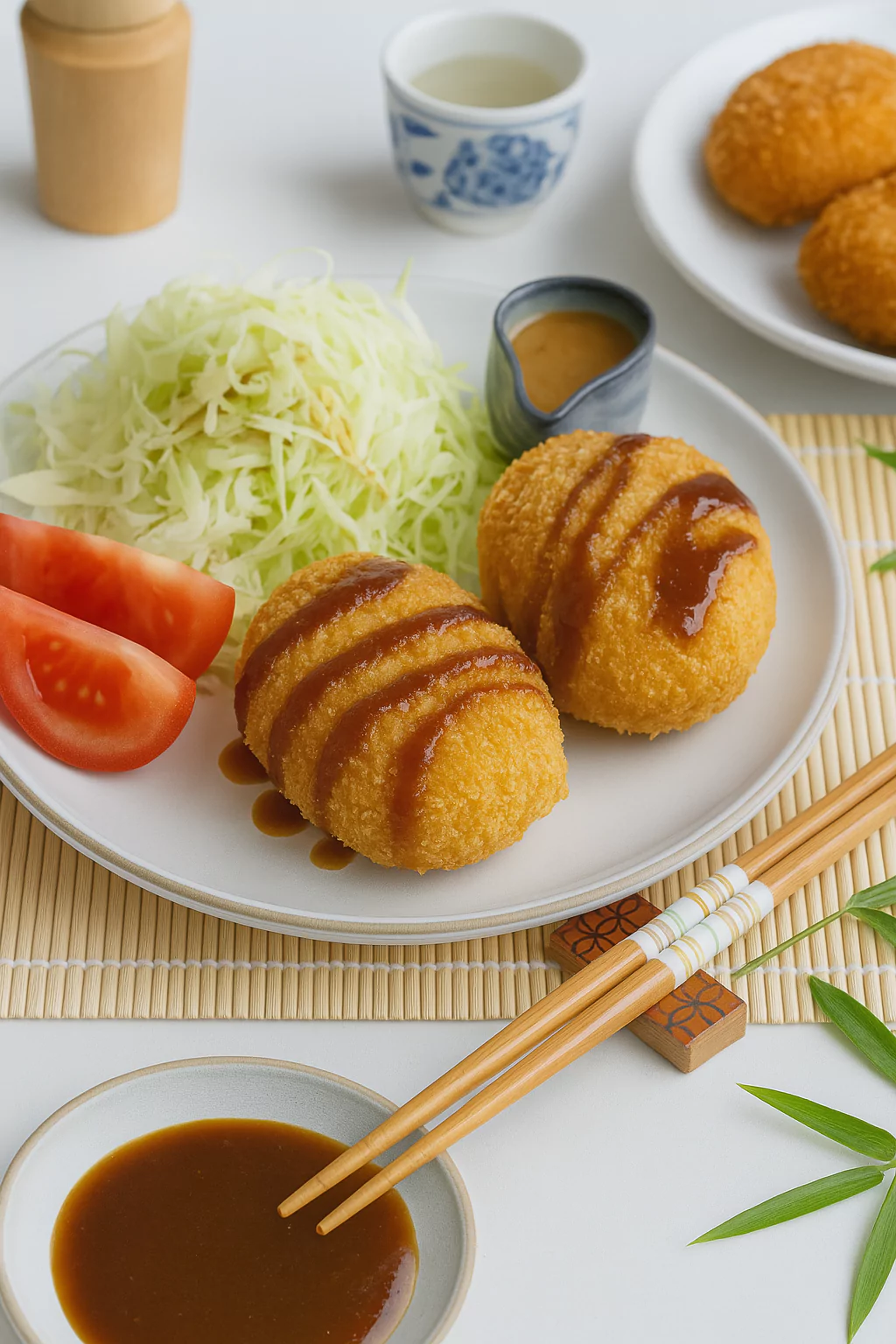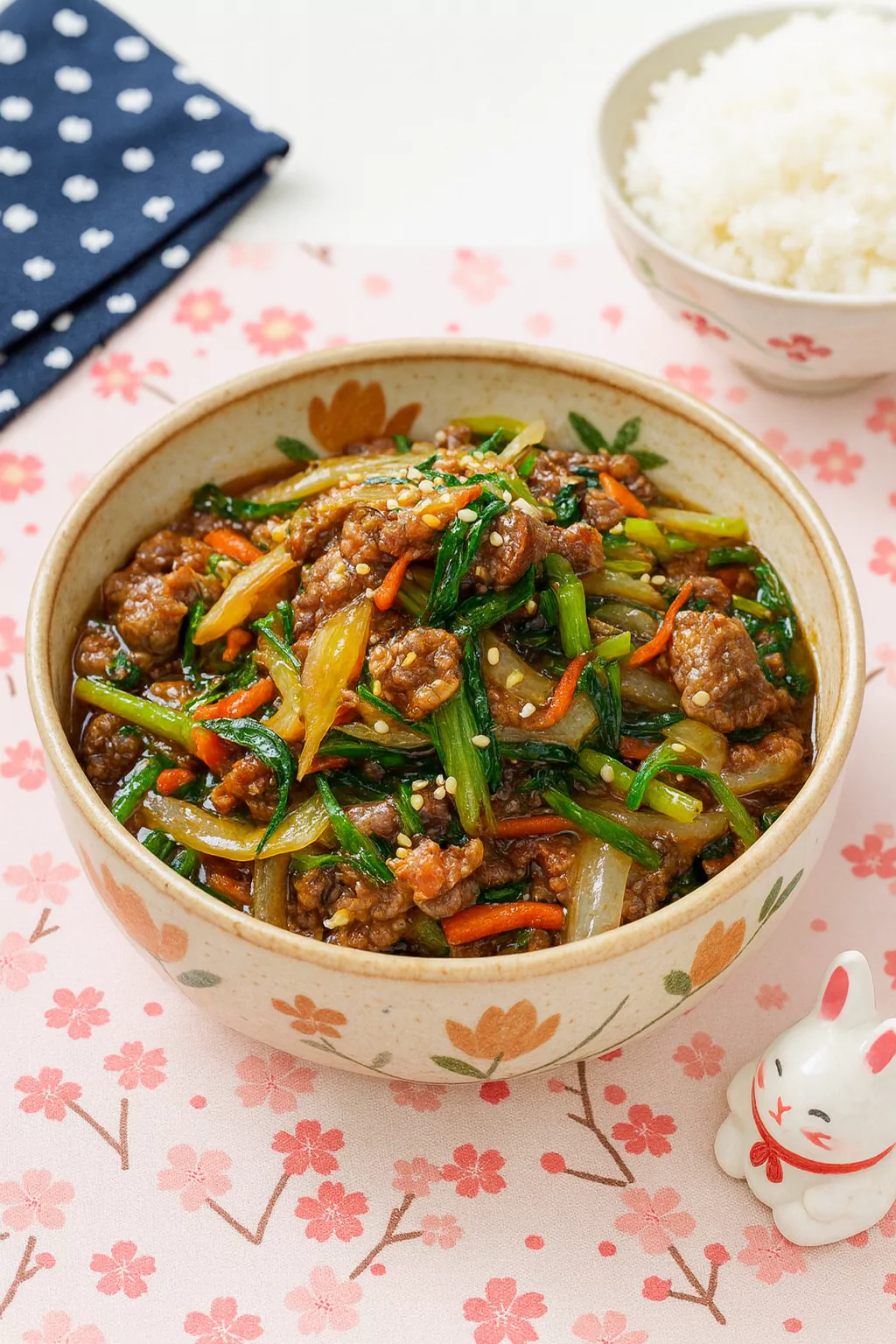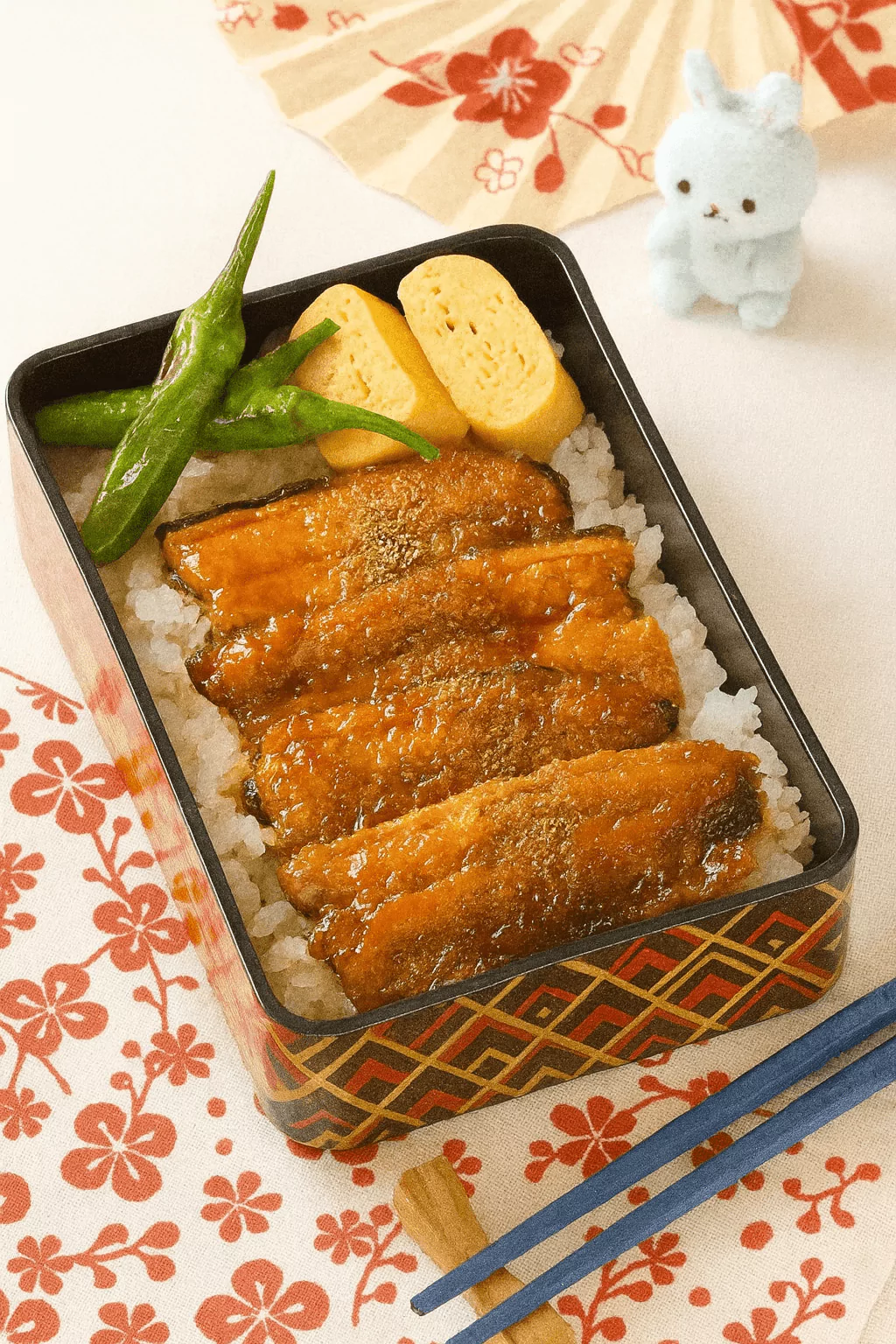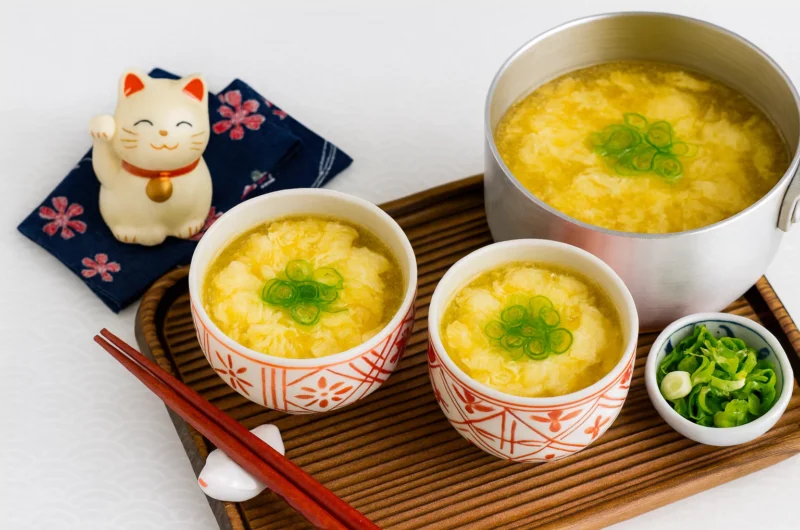Have You Ever Tried Japan’s Silkiest Egg Soup?
When most people think of egg drop soup, they imagine a Chinese-style bowl with floating egg ribbons. But did you know Japan has its own version? It’s called Kakitamajiru (かきたま汁), and it’s a warm, soothing, and beautifully simple dish that comes together in minutes. This bowl of golden goodness is packed with flavor, thanks to a light dashi broth and perfectly swirled eggs. So, what makes Japanese egg drop soup different—and why should you make it at home?
Let’s explore this delightful recipe together.
Overview of the Recipe
- Time Required: 10–15 minutes total
- Difficulty Level: Very easy
- Servings: 2 bowls
- Best For: Cold days, side dishes, quick lunches
This recipe is perfect for anyone looking for a warm, protein-packed soup that’s easy to prepare. It’s light but satisfying and works well on its own or with rice, tofu, or grilled fish.
What Is Kakitamajiru (かきたま汁)?
Kakitamajiru (かきたま汁) is a traditional Japanese egg soup made by swirling beaten eggs into a seasoned broth. The name comes from “kaku” (to stir) and “tamago” (egg). It’s known for its silky, cloud-like texture and light, umami-packed taste. Unlike thicker Western soups, Kakitamajiru is delicate and comforting—perfect as a side dish for any Japanese meal.
You’ll often see it served alongside rice and pickles, especially in bento boxes or as part of a simple home-cooked dinner.
Why You’ll Love This Recipe
- Quick to make: Ready in under 10 minutes.
- Simple ingredients: You only need a few pantry staples.
- Comfort food: Warm, soothing, and full of umami flavor.
- Beginner-friendly: Great for home cooks at any level.
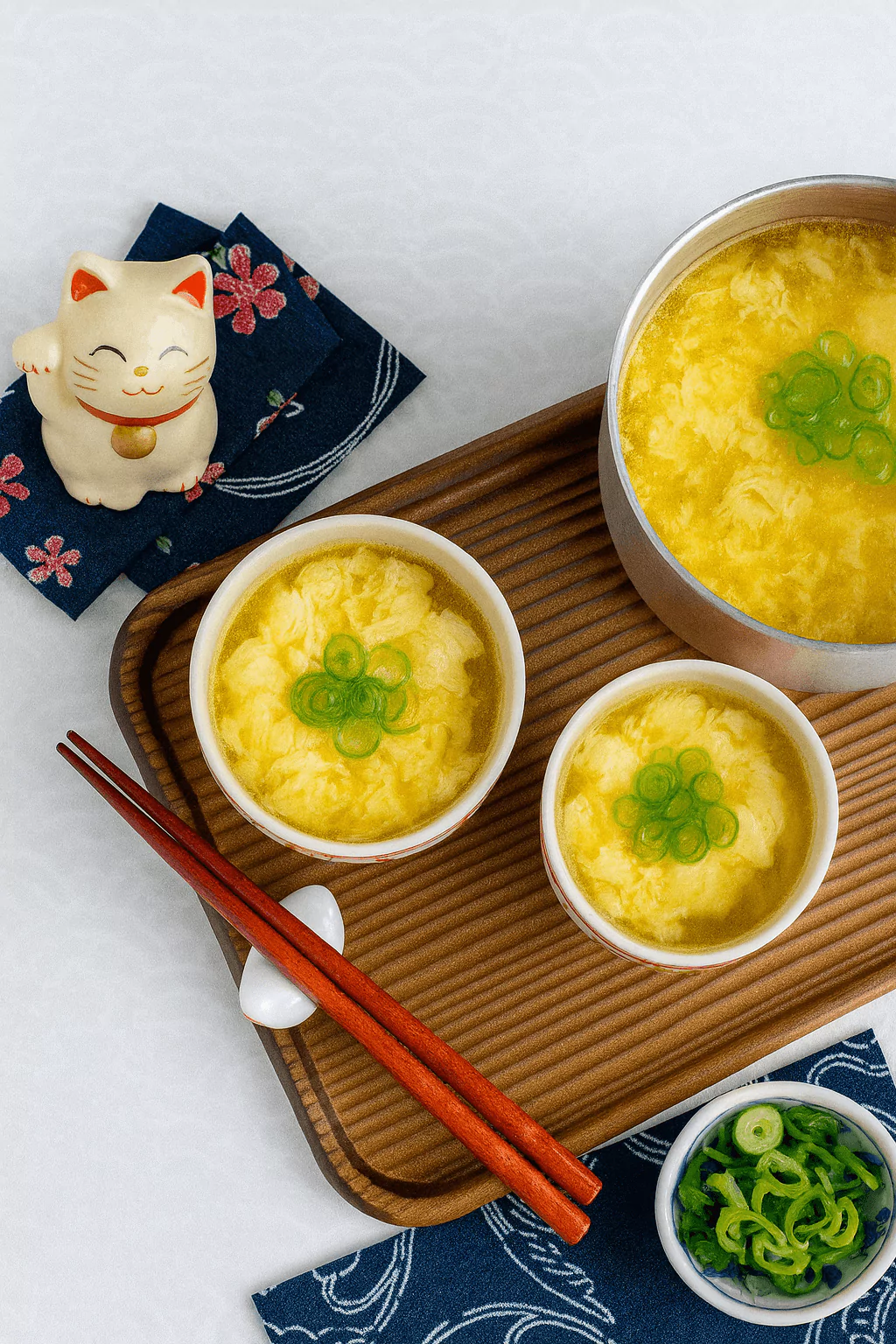
Kakitamajiru (かきたま汁) @JapanDishes
Essential Ingredients
Here’s what you’ll need to make authentic Japanese egg drop soup:
Main Ingredients
Here’s a closer look at the simple yet flavorful ingredients used to make Japanese Egg Drop Soup (Kakitamajiru) かきたま汁:
- Egg (1 piece): The heart of the dish. Beaten and gently stirred into the soup to create soft, cloud-like ribbons. Use fresh eggs for the best texture and color.
- Water (400 ml): Forms the soup’s base. Clean and light, allowing the other flavors to shine through.
- Chicken Stock Powder (2 teaspoons): Adds rich umami and depth to the broth. You can substitute with Japanese dashi powder for a more traditional taste.
- Soy Sauce (2 teaspoons): Brings a savory balance and a touch of saltiness. Use light soy sauce for a clearer broth if desired.
- Sesame Oil (1 teaspoon): Adds a warm, nutty aroma and smooth mouthfeel. Optional, but it enhances the overall flavor.
- Salt (a pinch): Fine-tunes the balance of flavors. Adjust to your taste at the end of cooking.
- Potato Starch (just under 1/2 tablespoon): Mixed with water to lightly thicken the soup and give it a silky finish. Cornstarch is a good substitute if needed.
- Water (1 tablespoon, for starch slurry): Used to dissolve the potato starch before adding to the soup. Helps avoid lumps and makes the texture smooth.
- Salt and Pepper (to taste): Final seasoning to brighten and balance the finished dish. White pepper adds a slightly sharper note than black, if preferred.
These simple ingredients come together to create a dish that’s elegant, satisfying, and true to Japanese home cooking.
Substitutions and Variations
- Chicken stock: Can be swapped with dashi powder for a more traditional Japanese flavor.
- Soy sauce: Use light soy sauce if you prefer a less dark soup.
- Potato starch: Cornstarch works in a pinch.
- Sesame oil: Optional, but it adds a nutty aroma.
Step-by-Step Instructions
Let’s walk through the steps to make Kakitamajiru from scratch:
Step 1: Prepare the Egg and Starch
- Crack the egg into a bowl and beat it well using a fork or chopsticks.
- In a separate small bowl, mix the potato starch with 1 tablespoon of water. This is called mizudashi katakuriko—a key step to getting a smooth texture.
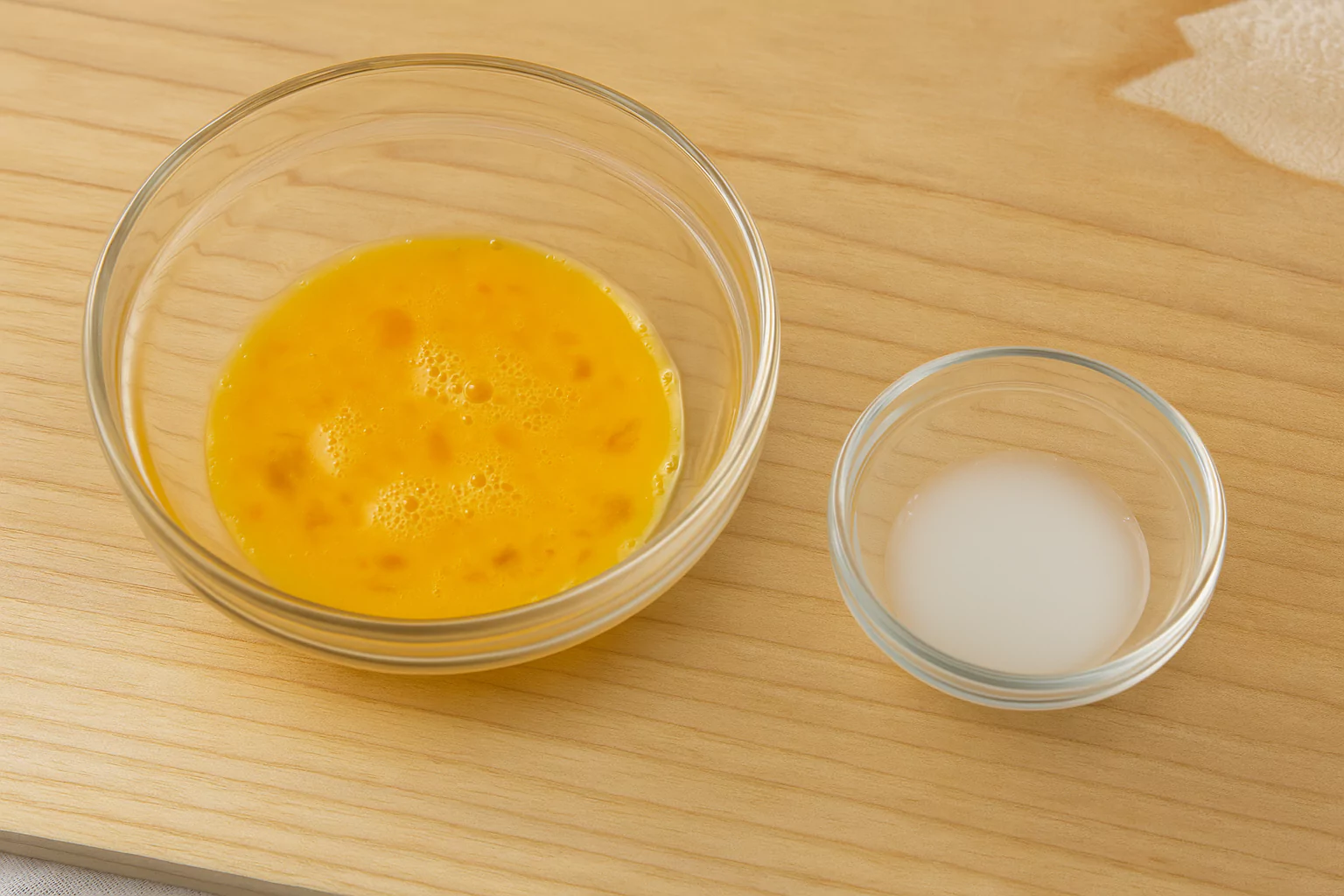
Step 2: Make the Soup Base
- In a medium saucepan, combine the following:
- 400 ml of water
- 2 teaspoons of chicken stock base
- 2 teaspoons of soy sauce
- 1 teaspoon of sesame oil
- A pinch of salt
- Bring everything to a gentle boil over medium heat, stirring occasionally.
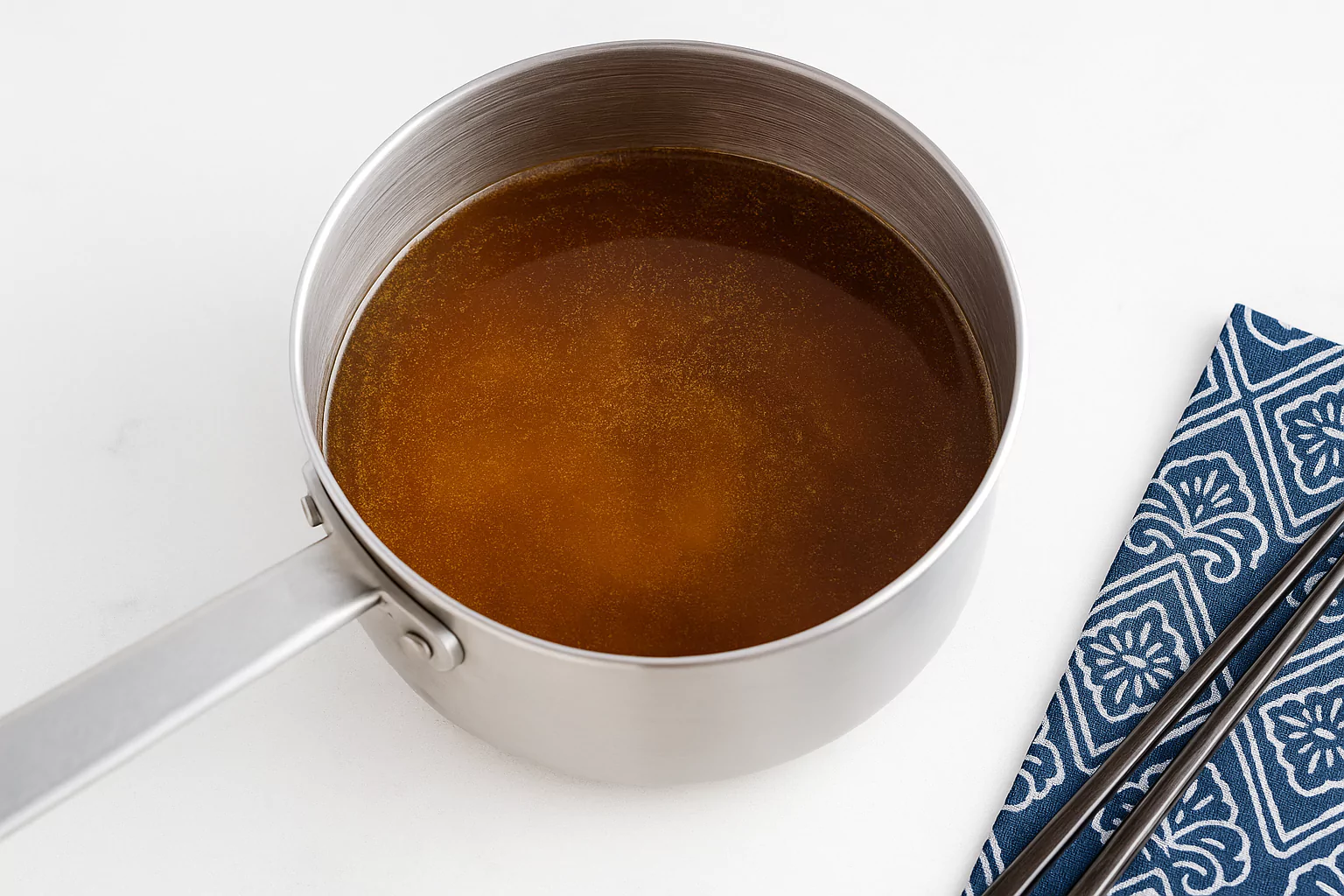
Step 3: Add the Egg
- Once the soup is boiling, turn off the heat and wait 5 to 10 seconds.
- Slowly drizzle the beaten egg into the soup while stirring gently with chopsticks in a circular motion.
- You’ll see the egg forming soft ribbons and clouds.
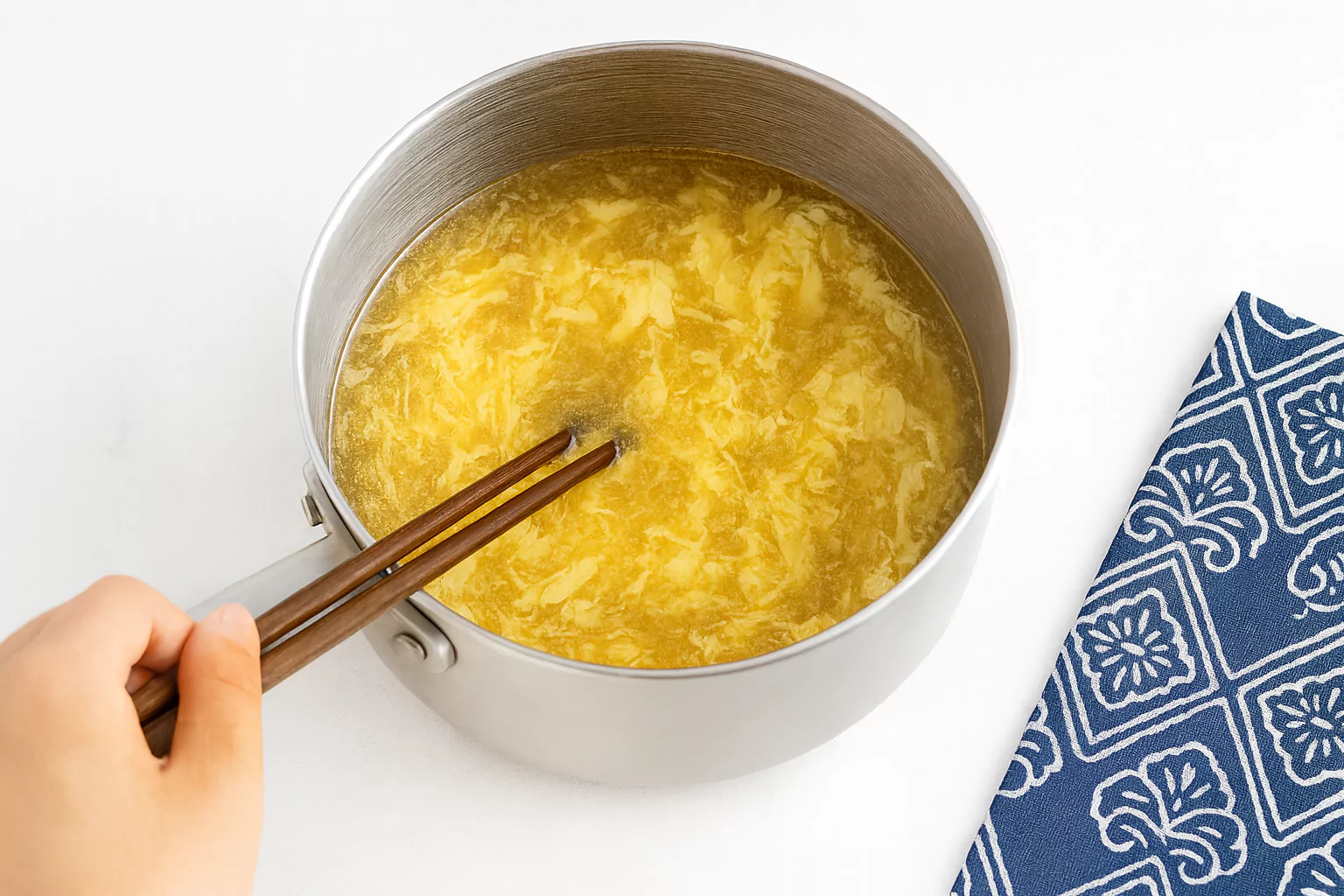
Step 4: Thicken the Soup
- While stirring slowly, add the potato starch mixture little by little.
- Stir gently until the soup becomes slightly thick, like a light sauce.
- Adjust with a bit of salt and pepper to taste.
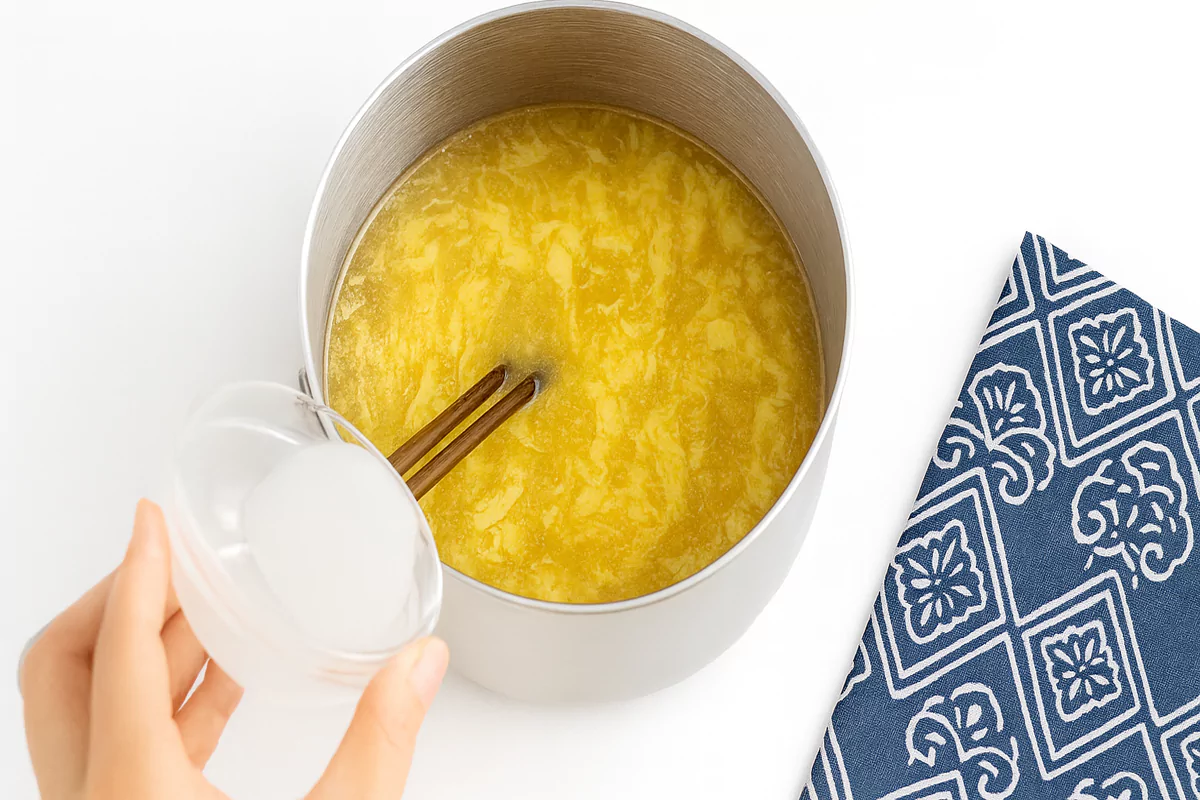
That’s it! You’ve made your own homemade Kakitamajiru.
Secrets to Success and Expert Tips
- Temperature matters: Don’t add the egg while the soup is boiling hard. Turn off the heat first. This creates soft, fluffy ribbons.
- Stir slowly: Gentle stirring ensures the egg spreads evenly.
- Don’t over-thicken: Use just enough starch to give it a silky feel, not a pudding texture.
- Use fresh eggs: The egg is the star here—use high-quality, fresh eggs if possible.
- Chopsticks trick: Stir with chopsticks instead of a spoon for delicate results.
Assembly and Presentation
Once your soup is ready, here’s how to serve it beautifully:
- Use a small Japanese-style bowl to highlight the elegance of the dish.
- Pour the soup gently so the egg ribbons remain fluffy.
- Garnish with a sprinkle of green onions, a tiny dash of yuzu zest, or a slice of kamaboko (fish cake) for a splash of color.
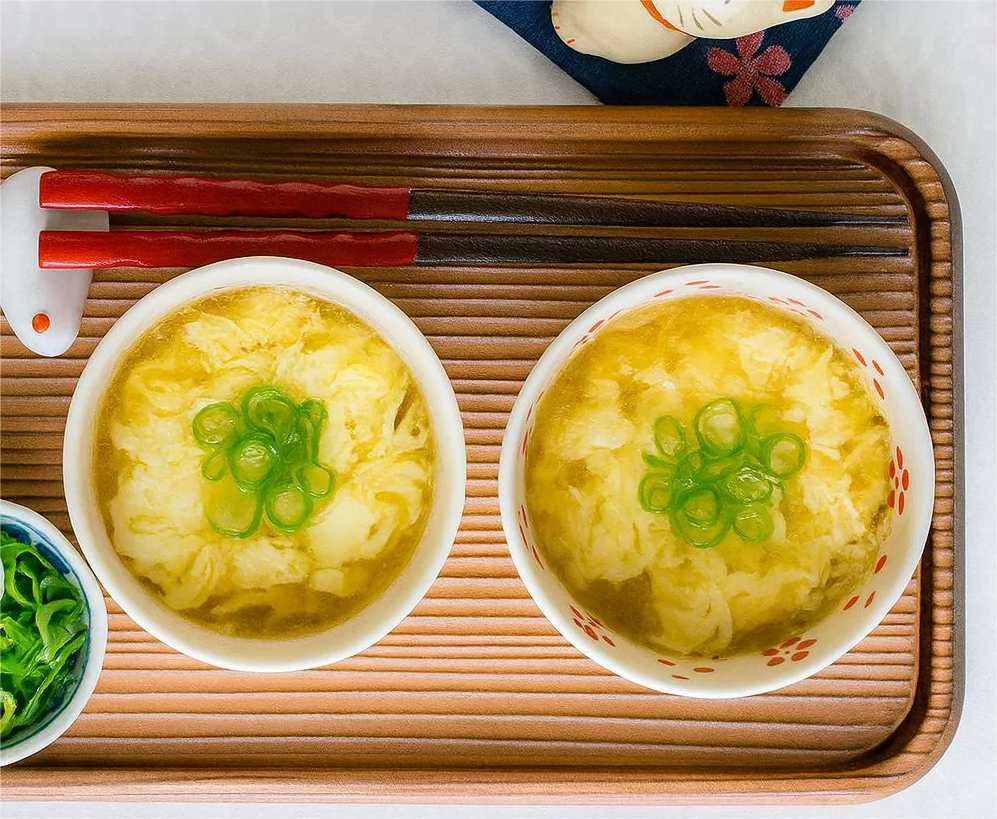
Kakitamajiru (かきたま汁) @JapanDishes
Hana’s Recipe Tips
“My grandma taught me to let the egg rest for 30 seconds before stirring—it makes the ribbons float like clouds. Also, I always add a tiny bit of grated ginger in winter. It warms the body and lifts the flavor without overpowering the soup.”
Storage and Make-Ahead Tips
Kakitamajiru is best enjoyed fresh, but if you have leftovers:
- Refrigerate in an airtight container for up to 24 hours.
- Do not freeze, as the egg texture will change.
- When reheating, warm gently over low heat without boiling, and stir slowly to avoid overcooking the egg.
Tip: The soup may separate slightly in the fridge—just stir gently before reheating.
What dishes pair well with Japanese egg drop soup?
Try serving it with steamed rice, grilled fish (like Saba Shioyaki), Japanese pickles, or a side salad. It also complements tamagoyaki or even a simple rice bowl.
Final Thought
This soup shows how something so simple—just an egg, water, and a few seasonings—can be incredibly satisfying. Try making it at home, and enjoy a true taste of Japan with every spoonful.
Recipe Variations
Looking to change things up? Try these tasty variations:
- Vegetable Kakitamajiru: Add thin slices of shiitake mushrooms, spinach, or grated carrot before adding the egg.
- Tofu Egg Drop Soup: Add small cubes of silken tofu for protein and a creamy texture.
- Seaweed Soup: Add rehydrated wakame or dried seaweed flakes for a traditional Japanese touch.
- Miso-Egg Fusion: Mix a spoon of miso into the broth before adding eggs for a deeper flavor.
- Spicy version: Add a few drops of chili oil or a pinch of shichimi togarashi for heat.
Related Recipes You May Like
If you enjoy traditional Japanese soups like Kakitamajiru, you’ll also love making your own Homemade Miso Soup (味噌汁) from scratch. It’s another iconic comfort dish packed with umami and perfect for beginners. Learn how to make the classic miso broth with tofu, seaweed, and scallions in our step-by-step guide.
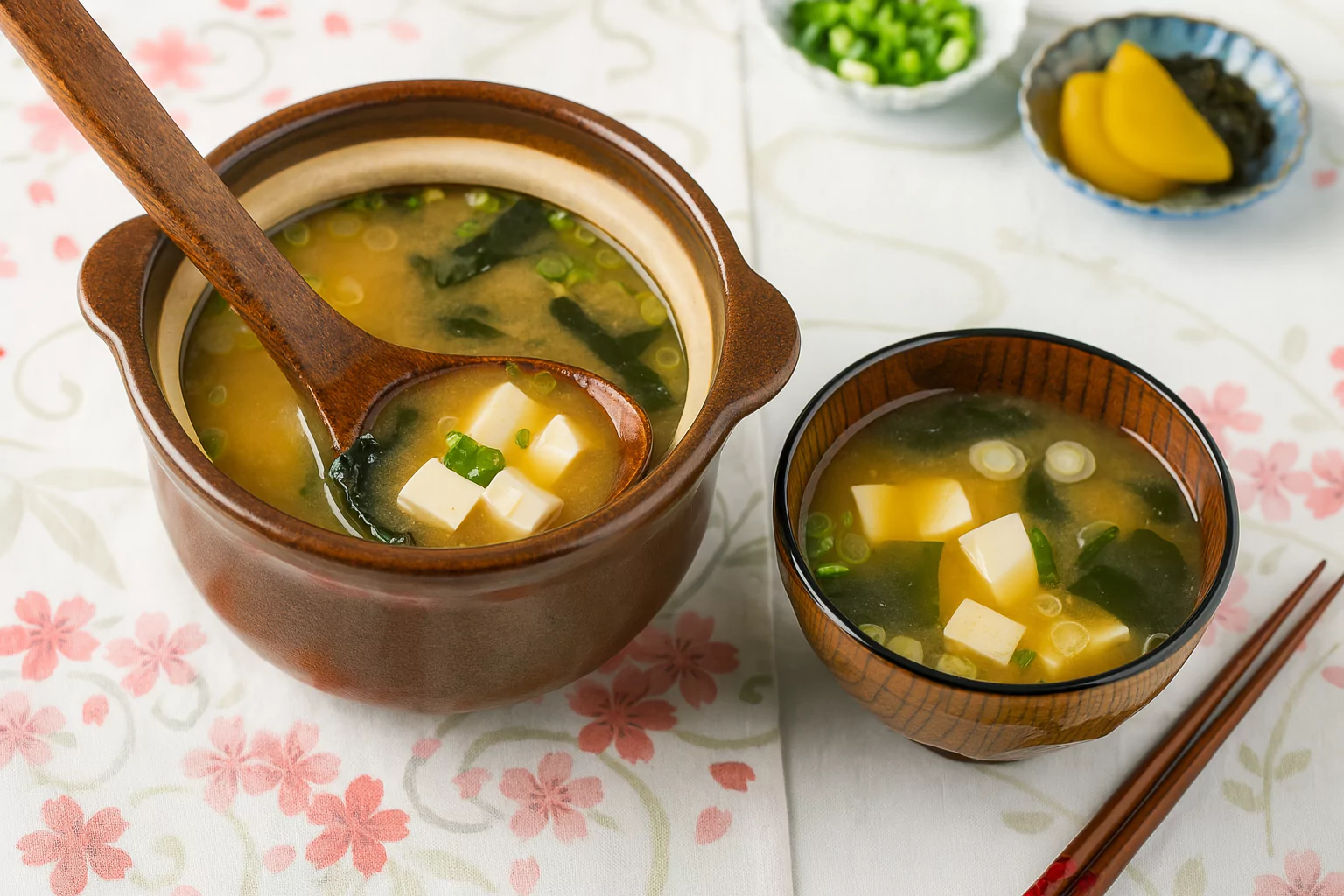
Conclusion
Japanese Egg Drop Soup (Kakitamajiru かきたま汁) is a comforting and quick dish that highlights the beauty of Japanese home cooking. It’s light, healthy, and full of umami, making it a perfect side dish or small meal on its own.
Whether you’re cooking for yourself or sharing with family, this soup is sure to warm the heart and body. Try it once, and you’ll find it becoming a regular part of your weekly meals.
So next time you’re short on time but want something soothing and flavorful, remember this little bowl of magic.
Frequently Asked Questions (FAQs)
What is the difference between Chinese and Japanese egg drop soup?
Chinese versions often use a clear chicken broth with thicker egg ribbons. Japanese egg drop soup uses a lighter broth (often with dashi or chicken stock), and the eggs are stirred gently for a softer texture.
Can I use dashi instead of chicken stock?
Absolutely. Dashi gives it a more authentic Japanese flavor, especially when using kombu and katsuobushi.
Is Kakitamajiru healthy?
Yes! It’s low in fat, contains high-quality protein from eggs, and can be made with very little oil. You can also boost the nutrition by adding veggies or tofu.
Can I make it in advance?
You can prepare the broth ahead of time and add the eggs right before serving. The texture is best when fresh, but leftovers can be reheated gently.
Can I skip the starch?
Yes, but the soup will be more watery. The starch gives a nice body to the soup without making it heavy.
External Inspiration You’ll Enjoy
If you love exploring creative Japanese flavors beyond soups, here’s something fun: Pizza Hut Japan teamed up with a 165‑year‑old tea shop to launch a matcha dessert pizza. It’s a fascinating fusion of tea tradition and modern dessert innovation. Check out the full story here: Pizza Hut Japan — Matcha Dessert Pizza
This link not only makes your content richer but also gives readers a tasty detour into how matcha is being used in new and surprising ways.
Japanese Egg Drop Soup (Kakitamajiru) かきたま汁
Course: Main CoursesCuisine: JapaneseDifficulty: Easy2
servings5
minutes10
minutes~90
kcalIngredients
Egg (1 piece) – The key to creating silky, cloud-like ribbons in the soup.
Water (400 ml) – The simple base that carries all the flavors.
Chicken Stock Powder (2 teaspoons) – Adds savory umami depth; dashi powder can be used instead.
Soy Sauce (2 teaspoons) – Balances the broth with saltiness and umami.
Sesame Oil (1 teaspoon) – Gives a warm, nutty aroma and smooth finish.
Salt (a pinch) – Enhances overall flavor balance.
Potato Starch (just under ½ tablespoon) – Mixed with water to lightly thicken the soup for a silky texture. Cornstarch works as a substitute.
Water (1 tablespoon, for slurry) – To dissolve potato starch and avoid lumps.
Salt & Pepper (to taste) – Final seasoning for balance and brightness.
Directions
- Crack the egg into a small bowl and beat well until yolk and white are combined.
- In another dish, mix the potato starch with 1 tablespoon of water to make a smooth slurry; set aside.
- In a saucepan, add 400 ml water, chicken stock powder, soy sauce, sesame oil, and a pinch of salt. Bring to a gentle boil over medium heat.
- Once boiling, turn off the heat. Wait 5–10 seconds, then slowly drizzle the beaten egg into the broth while stirring gently in one direction with chopsticks or a spoon.
- While stirring slowly, add the starch slurry little by little until the soup slightly thickens.
- Taste and adjust seasoning with salt and pepper. Serve hot.
Notes
- ✪ For a more authentic Japanese flavor, replace chicken stock with dashi.
✪ Always turn off the heat before adding the egg for soft, fluffy ribbons.
✪ Garnish with chopped green onions, a sprinkle of white pepper, or a thin slice of kamaboko (fish cake) for presentation.
✪ The soup is best served fresh but can be refrigerated for up to 24 hours and reheated gently.
